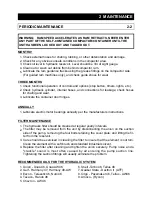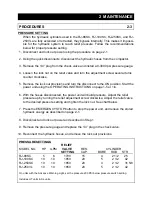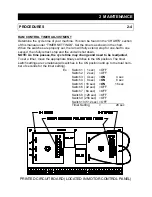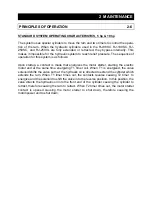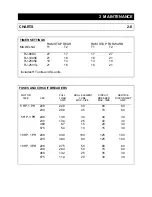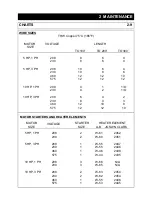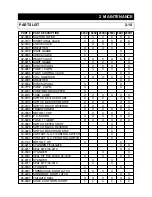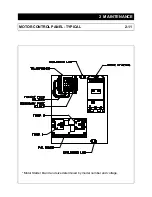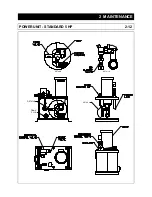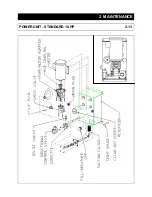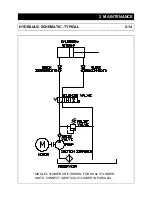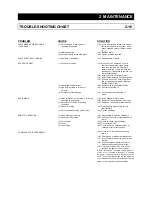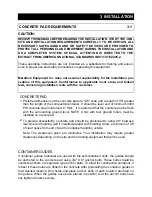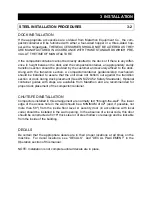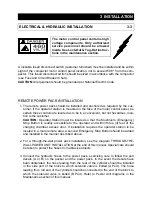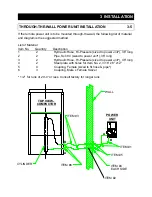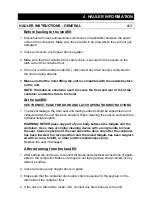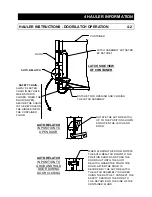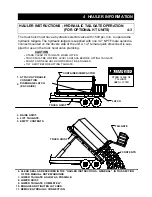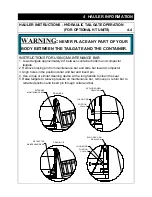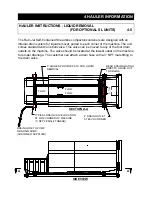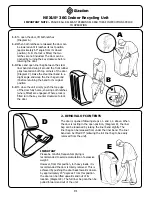
2 MAINTENANCE
TROUBLE-SHOOTING CHART
2-16
PROBLEM
PUMP MAKES NOISE-SOUNDS
LIKE GRAVEL
PUMP SHAFT SEAL LEAKING
EXCESSIVE HEAT
RAPID WEAR
ERRATIC OPERATION
OVERLOADS TRIP FREQUENTLY
CAUSE
( 1 ) Partly clogged intake strainer or
restricted intake pipe
( 2) Defective bearing
( 3) Air leak at pump intake pipe joints
( 1) Seal worn or damaged
( 1) Continuous running
( 2) Undersized hydraulic lines
( 3) High ambient temp in relation to
oil temp.
( 4) Excessive system leakage
( 1) Abrasive matter in the hydraulic oil being
circulated through pump
( 2) Viscosity of oil too low at working
conditions
( 3) Pressure too high
( 4) Air recirculation causing pump noise
( 1) Valve sticking or binding
( 2) Viscosity of oil too high
( 3) Air in system
( 4) Low oil
( 5) Low voltage
SOLUTION
( 1A) Pump must receive intake fluid freely or
cavitation results. Drain system, clean
intake pipe and clean or replace strain-
er
( 2A) Replace pump
( 3A) Tighten joints as required.
( 1A) Replace seals or pump.
( 1A) When over 140 degrees F or hot in
comparison with circuit lines, pump
should be shut down immediately.
Before restarting, insure that fluid cool-
ing capacity is adequate to remove sys-
tem generated heat.
( 1B) Install oil cooler (air or water type)
( 1C) Install oil temperature shut down switch
( 1D) Check to be sure CYCON Power Pack
has not been exchanged for Pressure
Shifting Power Pack.
( 2A) Replace with larger hydraulic lines
( 3A) Use lower viscosity oil
( 4A) Check system for bypassing or
leaks
( 1A) Install adequate filter or clean.
( 1B) Replace oil more often and clean tank
( 2A) Replace oil with factory recommended .
( 3A) Reduce pump pressures to factory
specifications.
( 4A) Tighten all fittings.
( 1A) Disassemble & clean as necessary
( 2A) Change oil to factory recommended vis-
cosity
( 3A) Check for leaks, tighten fittings
( 4A) Fill reservoir with oil
( 5A) Check primary & secondary sides of
transformer for correct voltage.
( 1A) Check for correct voltage (incoming
power.)
( 1B) Check fuses or breakers at disconnect
( 1C) Check heater elements to be sure they
are tight
( 1D) Check wiring from starter to motor to
make sure all connections are tight
( 1E) Check motor leads to be sure all con-
nections are tight surges or voltage
NOTE: Excessive overload tripping and/or
motor or coil failures may occur if voltage
surges or voltage drops are frequent in your
area. This circumstance can be remedied by
the installation of phase protectors which drop
power to the motor if surges are present.

